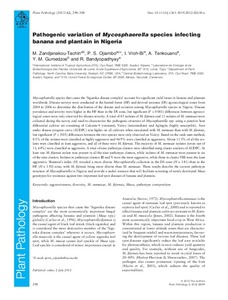| dc.contributor.author | Zandjanakou-Tachin, M. |
| dc.contributor.author | Ojiambo, P. |
| dc.contributor.author | Vroh Bi, Irie |
| dc.contributor.author | Tenkouano, A. |
| dc.contributor.author | Gumedzoe, Y.M. |
| dc.contributor.author | Bandyopadhyay, Ranajit |
| dc.date.accessioned | 2019-12-04T11:03:24Z |
| dc.date.available | 2019-12-04T11:03:24Z |
| dc.date.issued | 2013 |
| dc.identifier.citation | Zandjanakou?Tachin, M., Ojiambo, P. S., Vroh?Bi, I., Tenkouano, A., Gumedzoe, Y. M., & Bandyopadhyay, R. (2013). Pathogenic variation of Mycosphaerella species infecting banana and plantain in Nigeria. Plant Pathology, 62(2), 298-308. |
| dc.identifier.issn | 0032-0862 |
| dc.identifier.uri | https://hdl.handle.net/20.500.12478/1048 |
| dc.description.abstract | Mycosphaerella species that cause the ‘Sigatoka disease complex’ account for significant yield losses in banana and plantain worldwide. Disease surveys were conducted in the humid forest (HF) and derived savanna (DS) agroecological zones from 2004 to 2006 to determine the distribution of the disease and variation among Mycosphaerella species in Nigeria. Disease prevalence and severity were higher in the HF than in the DS zone, but significant (P < 0Æ001) differences between agroecological zones were only observed for disease severity. A total of 85 isolates of M. fijiensis and 11 isolates of M. eumusae were collected during the survey and used to characterize the pathogenic structure of Mycosphaerella spp. using a putative host differential cultivar set consisting of Calcutta-4 (resistant), Valery (intermediate) and Agbagba (highly susceptible). Area under disease progress curve (AUDPC) was higher on all cultivars when inoculated with M. eumusae than with M. fijiensis, but significant (P < 0Æ05) differences between the two species were only observed on Valery. Based on the rank-sum method, 8Æ3% of the isolates were classified as highly aggressive and 46Æ9% were classified as aggressive. About 11Æ5% of all the isolates were classified as least aggressive, and all of these were M. fijiensis. Themajority of M. eumusae isolates (seven out of 11; 64%) were classified as aggressive. A total of nine pathotype clusters were identified using cluster analysis of AUDPC. At least one M. fijiensis isolate was present in all the nine pathotype clusters, while isolates of M. eumusae were present in six of the nine clusters. Isolates in pathotype clusters III and V were the most aggressive, while those in cluster VIII were the least aggressive. Shannon’s index (H) revealed a more diverse Mycosphaerella collection in the DS zone (H = 1Æ81) than in the HF (H = 1Æ50) zone, with M. fijiensis being more diverse than M. eumusae. These results describe the current pathotype structure of Mycosphaerella in Nigeria and provide a useful resource that will facilitate screening of newly developed Musa genotypes for resistance against two important leaf spot diseases of banana and plantain. |
| dc.language.iso | en |
| dc.subject | Musa |
| dc.subject | Mycosphaerella Fijiensis |
| dc.subject | Pathogens |
| dc.subject | Pathotypes |
| dc.title | Pathogenic variation of Mycosphaerella species infecting banana and plantain in Nigeria |
| dc.type | Journal Article |
| dc.description.version | Peer Review |
| cg.contributor.crp | Roots, Tubers and Bananas |
| cg.contributor.affiliation | International Institute of Tropical Agriculture |
| cg.contributor.affiliation | Université de Lomé |
| cg.contributor.affiliation | North Carolina State University |
| cg.coverage.region | Africa |
| cg.coverage.region | West Africa |
| cg.coverage.country | Nigeria |
| cg.isijournal | ISI Journal |
| cg.authorship.types | CGIAR and developing country institute |
| cg.iitasubject | Banana |
| cg.journal | Plant Pathology |
| cg.howpublished | Formally Published |
| cg.accessibilitystatus | Limited Access |
| local.dspaceid | 78046 |
| cg.identifier.doi | https://dx.doi.org/10.1111/j.1365-3059.2012.02650.x |

